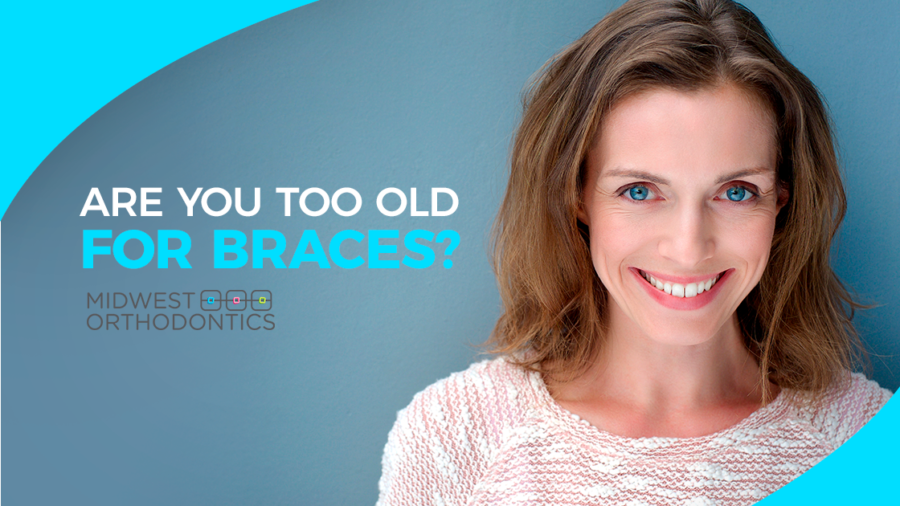Are You Too Old for Braces? Read On To Find Out
We often get asked, ” Am I too old for braces“? While braces have become commonplace for children and teens, there are entire generations who missed out on having their teeth straightened as kids. Generation X and even some Millennials now find themselves wondering if it’s too late for them to get braces.
Maybe your parents didn’t have dental insurance when you were growing up. Maybe you didn’t want to be labeled as the nerdy kid with braces. Or maybe you had braces as a child but didn’t wear a retainer so your teeth have shifted again.
Do any of these situations apply to you? If the answer is yes, then we have some good news – you’re not too old braces after all!
Myths and Misconceptions
One of the biggest myths surrounding adults and braces is that your teeth are set into place once you reach adulthood and cannot be corrected with braces. This is not the case.
Think of teeth the way you would any other bone on your body. They do stop growing at the end of adolescence, but it’s still possible to correct them throughout your life. If your arm breaks, it can heal and be put back into place with a cast. Teeth are no different.
As an adult, it will likely take longer for braces to correct your teeth than it would for a child. Specific wearing time varies from person to person, but the average is about two years.
Another misconception is that braces are too expensive if they are not covered by insurance. While this might have been true at one time, some things have changed. Many orthodontists now realize that no one should have to live with misaligned teeth, regardless of their financial situation. At Midwest Orthodontics, we will work with you to make braces fit into your budget, even if you do not have dental insurance. You can click here to view some of our financing options.
Correcting Dental Problems
Aside from cosmetic benefits, braces can help correct a multitude of dental problems — and potentially save you from needing crowns or dentures down the road.
When your teeth are not aligned they are more difficult to clean, which leads to tooth decay and cavities. Misaligned teeth can also cause speaking or chewing problems, or even headaches and earaches. Braces can correct these issues.
However, if you suffer from gum disease or other problems with your gums, braces might not be an option right away. Gum issues will need to be addressed by your general dentist before braces are fitted.
In addition, years of dental work like crowns, root canals, and cavity fillings can make it harder for braces to work because parts of your teeth have been replaced by artificial substances. An orthodontist can determine whether you are a good candidate for braces given your dental history.

More Than a Mouth Full of Metal
Traditional metal braces use gentle pressure to move your teeth into place over time. Brackets are glued to the front of your teeth and connected with a wire. The wire then gets tightened every 4 to 6 weeks. This action slowly moves your teeth and jaw into proper alignment.
Metal brackets are still the most commonly used type of braces, but there are other options available for adults who are looking for something a little less noticeable and/or invasive.
Clear aligners are plastic trays that fit over your teeth. Invisalign is the most widely known brand in this market. Aligners are customized to your teeth and are removable, making them easier to clean and maintain. However, they are only intended for smaller adjustments. Brackets are required to close larger teeth gaps.
Ceramic braces offer a middle ground between metal braces and clear aligners. They are similar to metal braces but the brackets are customized to the color of your teeth, making them less noticeable. Because of this customization, ceramics typically cost more than metal braces.
Another option are lingual, or concealed, braces that attach to the back of your teeth and are less noticeable than braces worn on the front of your teeth. Be aware, though, that the placement against the back of your teeth can lead to speaking problems and tongue damage over time.
Learn More
According to the American Association of Orthodontists, more and more adults are realizing they are not too old for braces. The association reports that in 2012 about 1.2 million people age 18 and older received treatment for braces. With life expectancy on the rise, even someone who is age 50 will likely have 30-40 more years with their teeth.
The only way to know whether you are a good candidate for braces is by visiting an orthodontist for a consultation. Most orthodontist will work in conjunction with your dentist to address your dental history and any issues that may need to be addressed before proceeding with braces.
Our team will provide a thorough assessment and an honest opinion on whether you are too old for braces or not. Contact us today to get started.



1 Comment
Leave your reply.